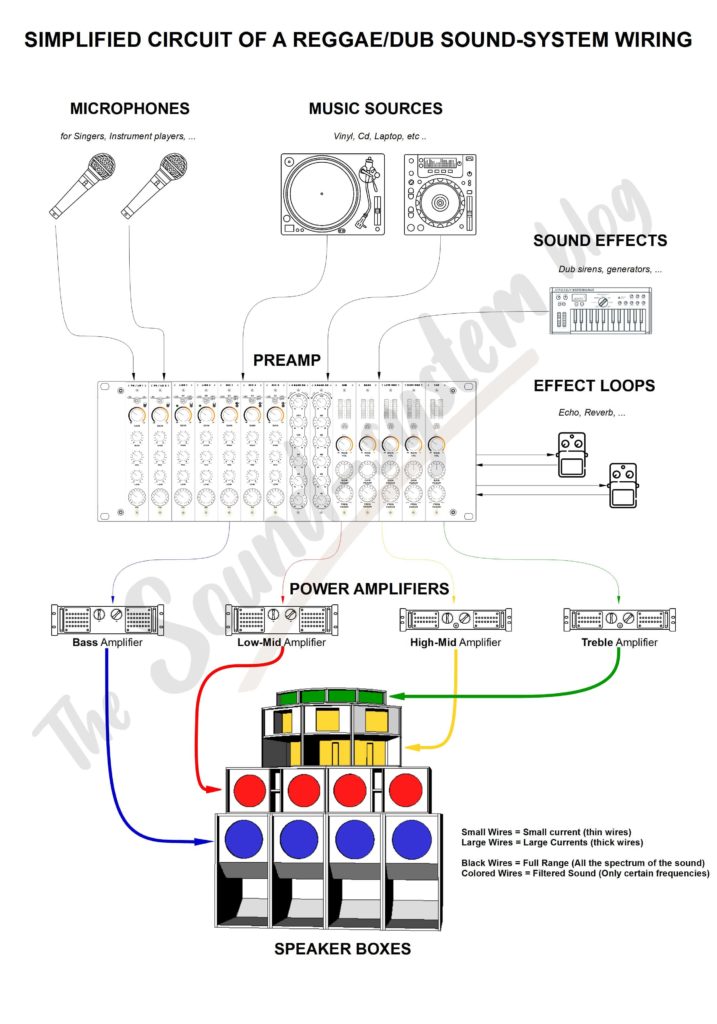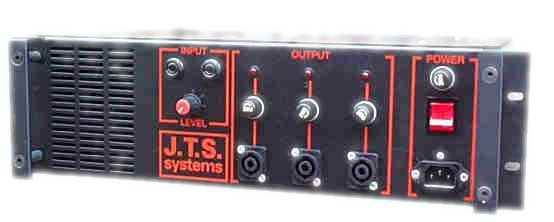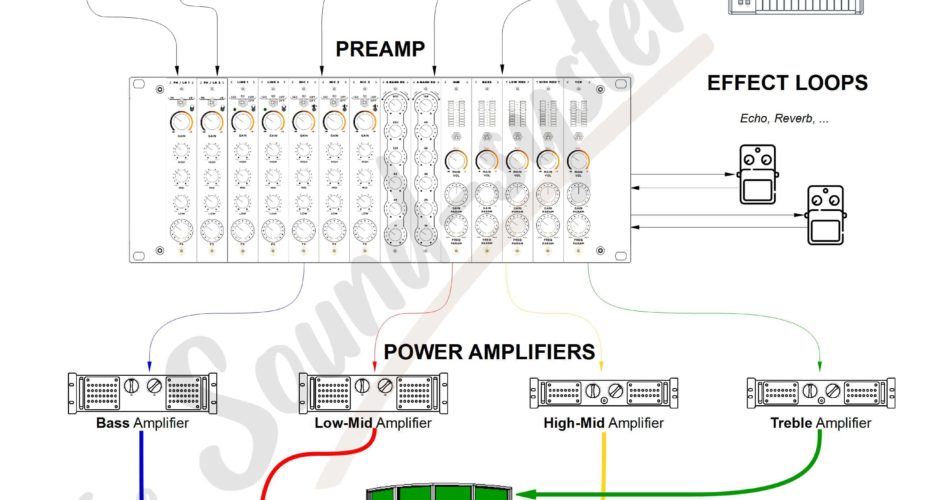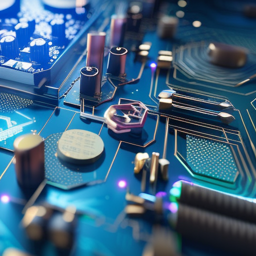I love schematics and drawings, I found it is really more explicit than long sentences. Let’s say that both are complementary, but that most of the information can be synthesised with a good drawing or a good diagram.
I have tried to represent how a reggae sound-system works by drawing this operating diagram that sums up the various wiring and equipment used.
Let’s begin by the crew, there is often a team and a crew at the back of all these adventures. It can be one single person, two or 10. Often, we can distinguish several “roles” in the crew, each team is free to use it and set it, or not.
In fact, I imagine that it comes naturally depending the desires and skills of every member of the team…
The main roles in a reggae sound
In this section I won’t talk about all the essential persons that organises the session, the ones that comes to help, the volunteers, the musicians, … without whom having a sound-system wouldn’t be usefull but using it at home….
Let’s begin the the selector, or selecta. He manages the musical selection. It’s not simply play a playlist.. Its role is to “lead the dance” in order to make the public travel, by creating a musical progression and an evolution during the party, by constantly adapting itself to the feedback of the public, etc.
The selector is kind of the “DJ” of the crew. Traditionnally he brings vinyl records, or now his USB stick, loaded of carefully selected musical chips, to mash up the dance !
Next, we can then talk about the operator, because it is kind of the duo with the operator (it can sometimes be only one person). The person that does the operation is, in general, the one who has more technical skills, he or she is in charge of setting the sound-system to make the sound optimal, no matter the played track.
It is thus often necessary to compensate and adapt the settings of the preamp at each track change.
Indeed, depending on the recording material, the age of the track, the quality of the mix and the mastering, …. there can be hughe differences in the general sound volume, in the feeling of the different frequencies,etc..
The operator is often in charge to manage the effets for the transitions between the tracks and also to manage the settings of the rest of the sound-system equipments (amplifiers, filters, wirings, …)
In traditionnal reggae sound-systems, there is also the MC, a singer that is part of the crew and animated the dance, introduce the tracks, engage and make the public react, etc ..
We can also talk about box-men and box-women, without whom the rest of the crew would simply break their back in a few years … 😂
Sound-system boxes are heavy !
Diagram of a reggae/dub sound-system
Before we come to how it works and to the small wiring diagram that I prepared for you, it is important to clarify that traditionally, the reggae sound-systems plays only with one single records player (turntable).
It has evolve a lot from the beginnings, there used to be the D.A.T (Digital Audio Tape), the CDs, and now we can come with all the selection on a USB stick !
I have the impression that there is a trend that keeps the vinyl alive, for sure it is not only the case in the reggae and dub sound-system domain.
So, here is my proposal of wiring diagram of a dub sound-system :

It’s beautiful, isn’t it ? 😃
It’s well simplified,though… We could add a lot of details on each element…
I think we can identify “famillies” of elements that compose this schematic, there are :
- All the sound sources (Microphones, CD, Vinyls, Effects, …)
- The preamp
- Power Amplifiers (Amps)
- Speaker Boxes (Boxes, Sound, Stack, …)
It is important to note that it is an actively filtered system, that means it has an amplifier per frequency band. For more info : Filtering and speakers : Active or Passive ?
Which equipment for a dub sound-system?
Sound sources
Music is generally recorded on a vinyl record, CD, or USB key more recently.
For the vinyl records, I’d say that the quality of press and the material the record is made from are really important.
For digital mediums, I would say that the CD can scratch and crumble with time… Instead, a USB stick could have problems with connectors that breaks (unsoldering from the electronic board), or read/write speed.
Indeed, It happened to me to have problems with (cheap) USB Sticks that caused a lag (slow down) to the CD players or to computers it was plugged in, juste because of their low transfer speeds.
The microphones and the audio effects, for example a Dub Siren, are not mandatory, but can be very usefull to make transitions for example.
Then, you have to plug all the sound sources into the preamp (or in a mixer if you have setup without preamp)
The Preamp
Well, it already has it’s dedicated article, but essentially it is one of typical reggae and dub sound-system unit, that includes, among others, mixing and filters functions.
The internal filter allows to “split” the sound in multiple frequency bands, and produce several separate outputs, each output is plugged into an amplifier.
The preamp is not mandatory, and can be replaced by a mixer and an active filter !
For more information on the pro/con and the choice of a preamp, I invite you to read the article dedicated to preamps.
Effect Loops
The effets has a predominant place in the sound-system because we often uses them to make transitions between tracks.
For the mix and transition between tracks, microphones and sound effects (Dub Siren, …), the echo chamber (also called delay or echo) is widely used.
We can also find Reverbs, but it is more used in the Mix, alongside many other effects…
See the article The effects for Dub music for more info.
Power amplifiers
The P.A. Sound-system equipment is widely used and we can now find it mostly everywhere on the second hand market, and at good prices. These amplifiers are said “Power Amps” because they provide a voltage amplification but mainly they have the ability to provide very large currents, compared to the rest of the upstream equipment that are low currents.
We can easily recognize if an equipment is using or providing large currents or small currents by looking at diameter of the electrical wires plugged into it.

The amplifiers are supposed to be “neutral” and amplify the sound without modifying it. Obviously there is often a gap between theory and practice. Between a entry-level priced amplifier and an amplifier that costs a few thousands of euros, between an amplifier said to be “Hi-Fi” and an amplifier said to be “P.A.”, the specifications and performances can very a lot.
The technology that an amplifier uses also play a big role in the caracteristics and the performance, and thus its “neutrality”, in the whole system.
Knowing the different types of amplifiers is very usefull to make your choice according to what you want in terms of performance and sound.
Generally speaking, the amplifiers and the speakers boxes together will determine the limits and the maximal sound level that can be produced by the sound-system.
There is also one thing to know, it is that, in the handcrafted sound-system domain, we mostly use the amplifiers really close to their limits and often in hard conditions. Thus it is really important to choose them properly.
Speaker Boxes
We often call them “boxes”. In Accoustics, what we call “Speaker enclosure”‘ is an ensemble composed of an enclosure (hard volume, box), loud-speakers (drivers, speakers) and eventually other elements (filters, connectors, etc.).
The loud-speakers transform the electrical signal from the amplifiers in an accoustic signal (air move), these are this transconductors (they transform on energy type into another).
Coupling the loud-speakers with the right enclosures is really a critical step for a good reproduction of the sound. We can for sure put any driver into any box, but the delivered sound will be far from optimal.
I talk about it a little bit longuer in the Best speaker boxes for your sound-system article.
Thanks for reading, I hope that this article was usefull !
🙏 If you liked it, please share on your social networks 🙏
And if you have any remark, an experience to share, or if you want to tell me wich subject you’d like for the next article :
Don’t hesitate to share in the comments below !




